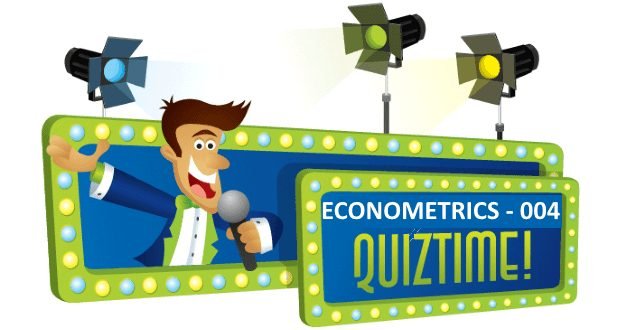500 câu trắc nghiệm Kinh tế lượng – 12B

Tổng hợp 500 câu trắc nghiệm + tự luận Kinh tế lượng (Elementary Statistics). Tất cả các câu hỏi trắc nghiệm + tự luận đều có đáp án. Nội dung được khái quát trong 13 phần, mỗi phần gồm 3 bài kiểm tra (A, B, C). Các câu hỏi trắc nghiệm + tự luận bám rất sát chương trình kinh tế lượng, đặc biệt là phần thống kê, rất phù hợp cho các bạn củng cố và mở rộng các kiến thức về Kinh tế lượng. Các câu hỏi trắc nghiệm + tự luận của phần 12B bao gồm:
SHORT ANSWER. Write the word or phrase that best completes each statement or answers the question. Provide an appropriate response.
1) Describe the sign test. What types of hypotheses is it used to test? What is the underlying concept?
The sign test compares the signs (negative or positive) of the differences for data sets, ignoring any ties resulting in a difference of zero. The sign test can be used to test claims involving two dependent samples, claims involving nominal data, and claims about the median of a single population. The underlying concept is that if two sets of data have equal medians, the number of positive signs should be approximately equal to the number of negative signs.
2) Describe the Wilcoxon rank-sum test. What type of hypotheses is it used to test? What assumptions are made for this test? What is the underlying concept?
The Wilcoxon rank-sum test looks at ranks but not signs for the data points. The test is used to test claims about the differences between two independent samples. The assumptions include: two randomly selected independent samples; testing the null hypothesis that the two independent samples come from the same distribution; and more than 10 scores in each of the samples. The underlying principle is that if two samples are drawn from identical populations and the individual scores are all ranked as one combined collection of values, then the high and low ranks should fall evenly between the two samples. For example, if low ranks are found predominantly in one sample with the high ranks in the other, then we suspect that the two samples are not identical.
Use the sign test to test the indicated claim.
3) An instructor gives a test before and after a lesson and results from randomly selected students are given below. At the 0.05 level of significance, test the claim that the lesson has no effect on the grade. Use the sign test.
| Before | 54 | 61 | 56 | 41 | 38 | 57 | 42 | 71 | 88 | 42 | 36 | 23 | 22 | 46 | 51 |
| After | 82 | 87 | 84 | 76 | 79 | 87 | 42 | 97 | 99 | 74 | 85 | 96 | 69 | 84 | 79 |
H0: There is no difference between before and after grades.
H1: There is a difference between before and after grades.
Test statistic: x = 0. Critical value: x = 2.
Reject the null hypothesis of no difference. There is sufficient evidence to warrant rejection of the claim that the lesson has no effect on grade.
4) A researcher wishes to study whether music has any effect on the ability to memorize
information. 89 randomly selected adults are given a memory test in a quiet room. They are then given a second memory test while listening to classical music. 66 people received a higher score on the second test, 22 a lower score, and 1 received the same score. At the 0.05 significance level, test the claim that the music has no effect on memorization skills.
H0: the music has no effect on memorization skills.
H1: the music has an effect on memorization skills.
Convert x = 22 to the test statistic z = -4.58. Critical values: z = ±1.96.
Reject the null hypothesis. There is sufficient evidence to warrant rejection of the claim that music has no effect on memorization skills
Use the Wilcoxon signed-ranks test to test the claim that both samples come from populations having the same distribution.
5) Use the Wilcoxon signed-ranks test and the sample data below. At the 0.05 significance level, test the claim that math and verbal scores are the same.
| Mathematics | 347 | 440 | 327 | 456 | 427 | 349 | 377 | 398 | 425 |
| Verbal | 285 | 378 | 243 | 371 | 340 | 271 | 294 | 322 | 385 |
Test statistic T = 0. Critical value: T = 6.
Reject the null hypothesis that both samples come from the same population distribution
Use the Wilcoxon rank-sum test to test the claim that the two independent samples come from the same distribution.
6) Use the Wilcoxon rank-sum approach to test the claim that students at two colleges achieve the same distribution of grade averages. The sample data is listed below. Use a 0.05 level of significance.
| College | A | 3.2 | 4.0 | 2.4 | 2.6 | 2.0 | 1.8 | 1.3 | 0.0 | 0.5 | 1.4 | 2.9 |
| College | B | 2.4 | 1.9 | 0.3 | 0.8 | 2.8 | 3.0 | 3.1 | 3.1 | 3.1 | 3.5 | 3.5 |
\({\mu _R}\) = 126.5, \({\sigma _R}\) = 15.2288, R = 108.5.
Test statistic: z = -1.18. Critical values z = ±1.96.
Fail to reject the null hypothesis. There is not sufficient evidence to warrant rejection of the claim that
the two populations are identical.